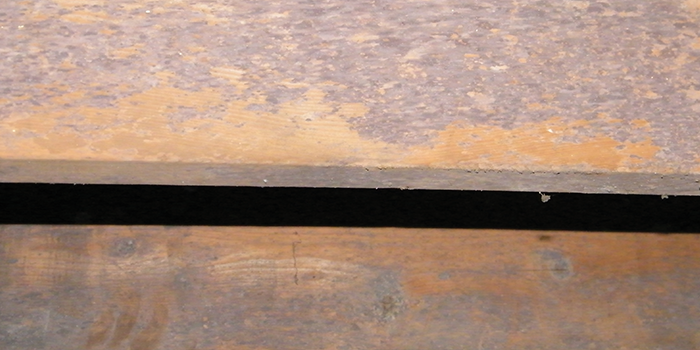Potential Mold Issues

Back to Education Center | Homeowners' Guide | Crawl Space Insulation
Mold: Prevention and Remediation
The presence of mold can cause severe health problems to building occupants. How does mold get in a home? To reproduce, molds produce tiny spores that float through the air. Mold spores can enter a home wherever outside air is coming in, be it an open door or a gap in the building envelope. When mold spores land on a damp spot inside, they may begin growing and digesting whatever they are growing on in order to survive. There are molds that can grow on wood, paper, carpet, and food. When excessive moisture or water accumulates indoors, mold growth will often occur, particularly if the moisture problem remains undiscovered or unaddressed. There is no practical way to completely eliminate mold spores from entering a home, but the way to control indoor mold growth is to control moisture. Thankfully, spray foam functions as an air barrier and a moisture barrier, giving homeowners a valuable tool for maintaining a healthy indoor environment.
Reports of mold remediation projects shutting down schools or office buildings have raised awareness regarding the potential hazards of interior mold contamination. While research into the effects of mold on human health is ongoing, it has been widely established by organizations like the U.S. Environmental Protection agency (EPA) that molds have the potential to cause health problems. So, basic knowledge about interior mold prevention and remediation is important for any homeowner.
Molds are fungus, like mushrooms or yeast. All fungal matter shares the common characteristic of being capable of growth without sunlight. Because of this, molds can be found almost anywhere and can grow on almost anything as long as moisture and oxygen are present.
Many types of molds exist, and they can have a variety of effects on the human health. For instance, some molds can produce allergens that trigger allegoric reactions or asthma attacks. Molds can also produce potent toxins and/or irritants that cause symptoms like coughing, congestion, sneezing, runny nose, rashes, and eye irritation.
Both the EPA and the Occupational Safety Health and Administration (OSHA) offer general guidelines for dealing with mold at home or in the workplace. The guidelines delineate the health effects from exposure, the signs by which to recognize mold, and recommendations for cleanup and remediation. Currently, there are no Threshold Limit Values (TLVs) assigned for airborne concentrations of mold or mold spores.
Mold Prevention and SPF
There is no feasible way to eliminate molds and mold spores indoors, so the most effective way to control indoor mold growth is to control moisture. Mold growth frequently occurs when excessive moisture accumulates indoors. In buildings where mold is a problem, the mold must be remediated and the sources of moisture eliminated.
This is where Spray Polyurethane Foam (SPF) can be used very effectively as a primary source of insulation. SPF seals the cracks, gaps, and holes in the exterior walls and roof (the building envelope) of a home or building. Spray foam firmly adheres to wherever it’s installed to create a monolithic layer that restricts the flow of air and moisture.
Moisture Control
Identify and repair leaky plumbing and other sources of water in a timely fashion to prevent moisture and mold growth. You can minimize mold growth by reducing indoor humidity to between 30 and 50 percent. This can be done by venting bathrooms, dryers and other moisture-generating sources to the outside; using air conditioners and dehumidifiers; increasing ventilation; and using exhaust fans whenever cooking, dishwashing, and cleaning.
Also, reduce the potential for condensation on cold surfaces like windows, piping, exterior walls, roofing, and floors by adding insulation. Do not install carpeting in areas where there is a continuous moisture problem, such as near drinking fountains, sinks or on concrete floors with leaks or frequent condensation.
In the event of water damage, it is important to dry wet areas and items within 24 to 48 hours to prevent mold growth from starting. Porous or absorbent materials—such as ceiling tiles, wallboard, or cellulose and fiberglass insulation—should be discarded and replaced. Discard non-valuable books and papers and be sure to photocopy important paperwork before discarding the originals. When it comes to carpeting, use a water extraction vacuum to remove excess water and then run dehumidifiers and fans to accelerate the drying process. Carpet that becomes moldy usually must be replaced. Nonporous surfaces can be vacuumed or wiped with mild detergent and allowed to dry completely.
Contamination Identification
A visual inspection is the most important initial step in identifying a possible contamination problem. This assessment is important in determining remedial strategies.
Ventilation systems should also be visually checked, particularly for damp filters, but also for damp conditions elsewhere in the system. Ceiling tiles, gypsum wallboard, cardboard, paper and other porous surfaces should be given careful attention during a visual inspection.
The use of special equipment to view spaces in ductwork or behind walls—or a moisture meter to detect moisture in building materials—may be helpful in identifying hidden sources of mold growth and the extent of water damage.
Mold Remediation
The EPA’s remediation guidelines are a tremendous resource for anyone facing a mold problem and offer detailed recommendations for a variety of mold removal scenarios.
Mold should be cleaned as soon as it appears. Small areas of mold can be cleaned using a detergent, soapy solution, or an appropriate household cleaner, and should be allowed to dry completely. A HEPA vacuum can be used to clean items such as furniture, concrete, carpeting or books after the material has been thoroughly dried.
For small areas of mold growth, an N95 respirator, goggles, and gloves should be worn during cleaning. For larger mold remediation jobs where long-term exposures are expected or high levels of airborne dust or mold spores are likely, the EPA suggests a full-face, powered air purifying respirator (PAPR) equipped with HEPA filters along with disposable coveralls, gloves and shoe covers. The cleaned area should be thoroughly dried. Dispose of any sponges or rags that were used to clean the mold, along with the used personal protective equipment.
If the mold returns quickly or spreads, it may indicate an underlying problem, such as a leak or excessive humidity. Any underlying water problems must be fixed to successfully eliminate mold problems. If mold contamination is extensive, an experienced remediation professional may need to be consulted.





























